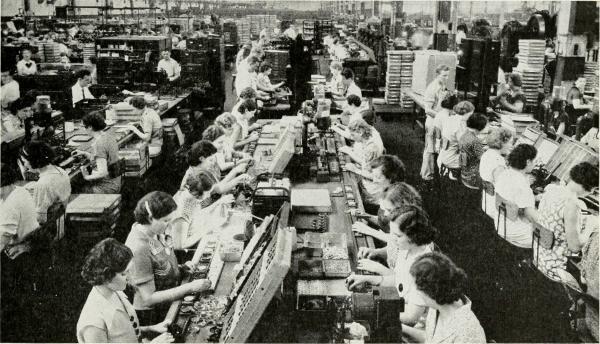
The Hawthorne effect is named after the same factory as the Western Electric Company of Hawthorne, Illinois (United States). At the beginning of the last century, the psychologist and sociologist Elton Mayo conducted a series of studies on the influence of the environment on productivity. During the study, the researchers realized that the workers reacted to a stimulus contrary to expectations: in particular, production increased even with the decline in the level of illumination. The conclusions, therefore, led to the recognition of the fact that being the object of observation triggered an accountability mechanism in the workers that nullified the effect of the stimulus. With this Psychology-Online article we will discover together what is the Hawthorne effect, its phases and some examples about.
Index
- What is the Hawthorne effect?
- Hawthorne's experiment
- Phases of the Hawthorne effect
- Examples of the Hawthorne effect
- Difference between placebo effect and Hawthorne effect
What is the Hawthorne effect?
Until today, with the Hawthorne effect it is understood the effect - produced in a totally involuntary way - induced on subjects conscious of being observed, but this phenomenon has for many years been at the center of a scientific debate obstinate. In other words, we can define it as a improved worker productivity due to a change in working conditions triggered by your response to an innovation or feeling of being the object of attention. It was Henry A. Landsberger, in a critique of the experiments, who gave what he considered a loophole in Mayo's search the term "Hawthorne effect."
Hawthorne's experiment.
Although the term was coined in the middle of the last century, the origins of the phenomenon date back to the 20s and 30s of the 20th century. In those years, the American Western Electric carried out a series of studies on worker productivity at its Hawthorne plant. In one set of experiments, the power of the light bulbs was varied to see how the light affected the productivity of women who assembled electrical components; In others, on the contrary, the rest periods were increased or decreased, the arrangement of the rooms was changed and the working days were shortened.
The first influential reports from these experiments concluded that productivity continued to grow regardless of whether The lights were softer or brighter or the working days were longer or shorter, or the working conditions improved or will get worse. The researchers concluded that productivity improvements were not due to changes in the workplace, but were due to his special role in the experiment made the workers believe they were noted and evaluatedSo they worked harder and harder.
Over the years, the idea that being part of an experiment influences the attitude of the subject has become known as the Hawthorne effect, and precisely these experiments have led to the psychology industrial, which in turn has evolved in various specializations, such as work psychology, health and positive psychology.
Phases of the Hawthorne effect.
The Hawthorne effect experiments occurred in several stages:
- Two groups were selected: a control group and the other on which to carry out the experiment by inserting it in a more illuminated environment. The results were so unusual that Mayo and her parents repeated the experiment several times, varying the lighting significantly. Unexpectedly, productivity had increased in both groups: This incomprehensible, but somehow interesting result, led to interrupt the experiments to make some reflection.
- A couple of years after May, together with a group of psychologists, he restructured the experiment with the participation of six workers from a relay editing department. The observation lasted five years, a period in which a series of parameters were modified, not only in the work environment, but also in wages, vacations and hours. Productivity increased, but Mayo and his group did not believe that there could be a close quantitative correlation with the variations they made. So they did a counter test, which brought the situation as it was at the beginning: productivity fell, but remained at high levels with respect to the other groups in the company. The conclusion reached by Mayo and his team was that the productivity of the six workers depended on the fact that felt as a group, and group under analysis.
- After more experiments and an avalanche of controversy, which even today are not completely sedated, in 1955 Landsberger analyzed the collected data and observed an interesting scheme (today known as the Hawthorne effect), concluding that these could be explained by the observer effect: that is, if it is observed, the behavior changes. He observed that workers exhibited short-term productivity gains in response to being under scrutiny; it didn't seem very important whether the light was high or low. He concluded that the fact that the study was communicated to workers suggested greater attention from management and produced a greater moral effect than changes environmental
Examples of the Hawthorne effect.
How does the Hawthorne effect affect companies? What was called the Hawthorne effect was nothing more than paying attention to the human aspect of the job. All he had to do was involve the six workers in the experiment, ask for their collaboration, listen to them, and involve them in the variations to be introduced. He gave them back the importance they had as an experimental group in which the company would change its strategy. The technical aspect was irrelevant, while the key was participation, feeling like a group.
The other aspect revealed by the investigations was that the intrinsic motivation in some cases it counts more than extrinsic, that is, the rewards that the six workers took from feeling part of the company, from being able to be heard and to take part in decision-making power, were greater than the rewards economic.
The Hawthorne effect, therefore, suggests that companies can achieve increased productivity by motivating employees and improving their perception of the work environment. A conclusion that gave impetus to the birth of contemporary human resources departments as responsible for supervising the hiring, training and development of the employees.
Difference between placebo effect and Hawthorne effect.
Probably the most complete definition of placebo is that of Dr. A. K. Shapiro, who, summarizing the different meanings that he proposes, it is possible to define the placebo as any procedure deliberately established to obtain an effect or which, even without being aware of it, acts on the patient or about the symptom or disease, but objectively lacks any specific activity with respect to the condition treated. This procedure can be applied with or without the knowledge that it is a placebo, which differs from the hawthorne effect, in which subjects are always aware that they are being observed.
This article is merely informative, in Psychology-Online we do not have the power to make a diagnosis or recommend a treatment. We invite you to go to a psychologist to treat your particular case.
If you want to read more articles similar to Hawthorne effect: what it is, phases and examples, we recommend that you enter our category of Human Resources.
Bibliography
- Bernini, E. (2013). Effetto placebo. Cos’è, thing says the scienza oggi, thing says the scienza di domani. Bologna: Area51.
- Decastri, M. et al. (2019). Progettare le organizzazioni. Le theory e i modelli per decidere. Milan: Angelo Guerrini e Associati.
- GEMA (2019). Elton Mayo and l’effetto Hawthorne. Recovered from: https://www.gema.it/blog/gestione-e-sviluppo-risorse-umane/effetto-hawthorne/
- Keegan, S. M. (2015). The Psychology of Fear in Organizations. New York: Kogan Page.
- Masci, S. (2007). Il conflitto in azienda. Analysis and management of the relazioni nei gruppi di lavoro. Rome: L’Airone Editrice.
- Randal Farmer, F. & Glass, B. (2011). Build system for web reputation. Milan: Tecniche Nuove.
- Stock, J. H. & Watson, M. W. (2005). Introduzione all’econometrics. Milan: Pearson.
- Tusini, S. (2006). La ricerca eats relazione. The interview nelle scienze sociali. Milan: Franco Angeli.


